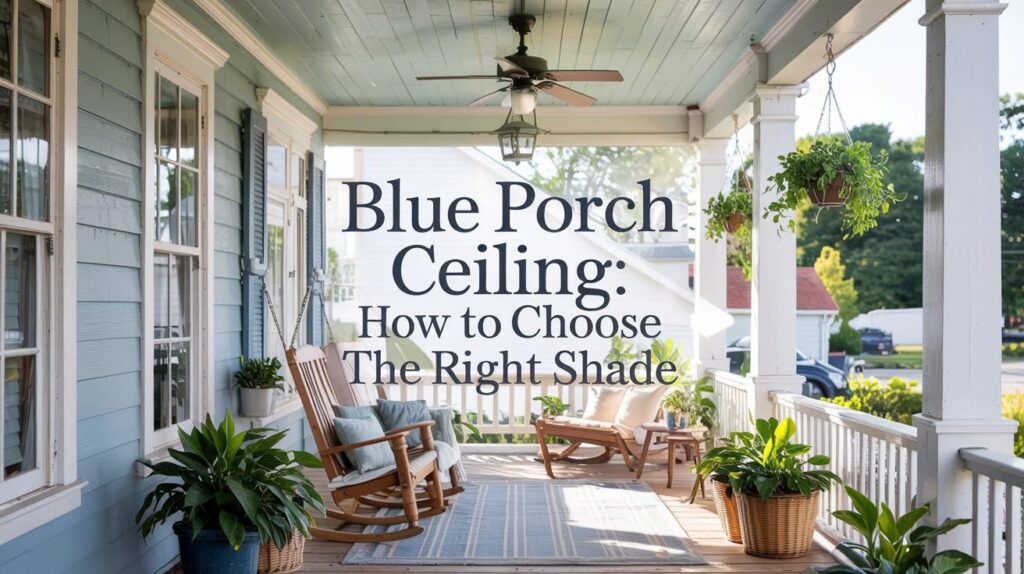The sight of a beautiful blue porch ceiling immediately catches the eye and adds instant character to any home’s exterior.
This classic design choice has gained renewed popularity as homeowners seek ways to create inviting outdoor spaces that feel both timeless and fresh.
From its rich cultural origins in the American South to its modern applications across the country, the blue porch ceiling represents more than just a color decision.
The practice involves painting your porch’s overhead surface in various shades of blue, creating a striking focal point that mimics the sky above while providing practical design benefits.
With proper shade selection and application techniques, this simple yet impactful improvement can transform your porch into a welcoming retreat that reflects your personal style.
What Is a Blue Porch Ceiling?
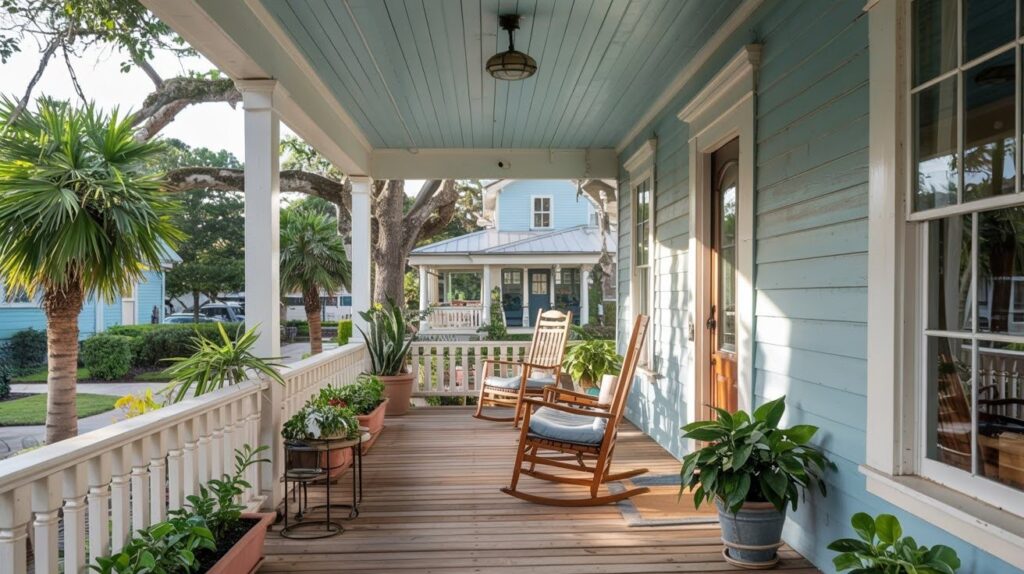
A blue porch ceiling is simply painting the overhead surface of your porch in blue paint. This popular design trend involves applying blue color to covered outdoor spaces like front porches, verandas, or patio overhangs.
Definition and Basic Explanation
The practice covers any shade of blue applied to porch ceilings, from light powder blue to deep navy. Homeowners use exterior-grade paint on wooden or other ceiling materials, creating a colored canopy over their outdoor living space. The blue coordinates with existing trim, siding, or accent colors.
Why It’s a Standout Design Element
Blue porch ceilings create immediate visual impact and serve as focal points for home exteriors. The color mimics the sky while defining the covered space, making porches feel both cozy and open.
This design choice works with multiple architectural styles – coastal, farmhouse, colonial, and contemporary homes all benefit from blue ceiling treatments. The color makes outdoor furniture and plants appear more vibrant while providing a cooling visual effect during sunny days.
The versatility allows homeowners to match their personal style through shade selection, making it an accessible way to add character to any porch space.
The Cultural History Behind Blue Porch Ceilings
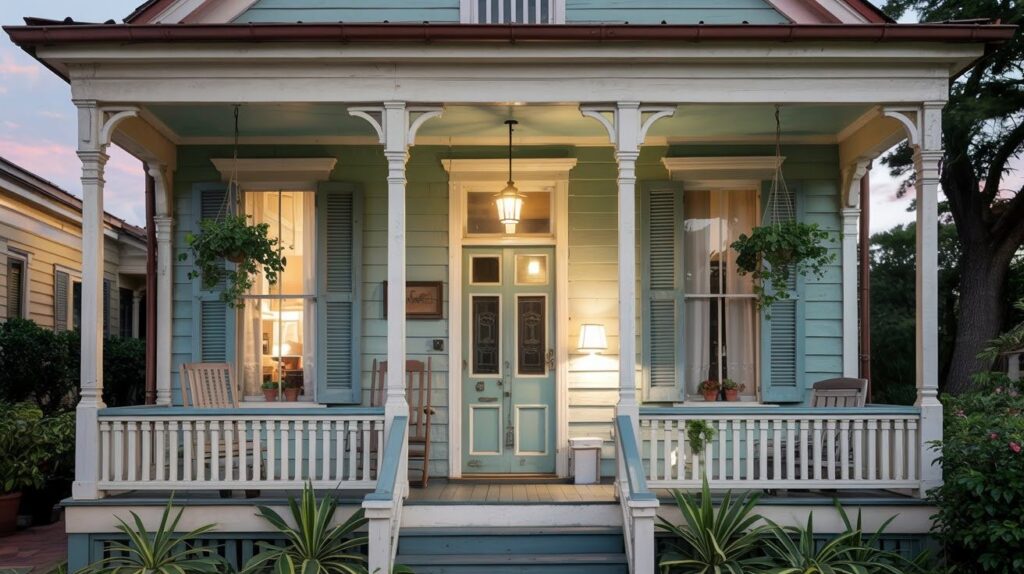
The tradition of painting porch ceilings blue carries deep cultural significance rooted in African American heritage and Southern folklore. This practice extends far beyond simple decoration, representing centuries of spiritual beliefs and protective customs.
The Gullah Geechee Tradition
The blue porch ceiling tradition originated with the Gullah Geechee people, descendants of enslaved Africans who lived in the coastal regions of South Carolina and Georgia.
These communities preserved African customs including spiritual practices related to color symbolism.
“Haint” refers to restless spirits or ghosts in Gullah folklore – souls that couldn’t find peace and might cause trouble for the living.
“Haint blue” became the specific term for the pale blue-green color used to repel these spirits. This particular shade, often described as a soft aqua or powder blue with green undertones, was considered the most effective color for spiritual protection.
Folklore and Spiritual Beliefs
The protective power of blue paint stemmed from the belief that spirits couldn’t cross water, and the blue color represented water or sky – both natural barriers to supernatural entities. The tradition held that spirits would mistake the blue surfaces for water and avoid crossing them.
Strategic placement of blue paint focused on entry points and overhead spaces where spirits might enter homes.
Porch ceilings received blue paint because they covered primary gathering spaces. Doors, shutters, window frames, and door trim also received blue treatment, creating a complete protective barrier around the home’s most vulnerable points.
This systematic approach reflected the serious nature of these beliefs and the importance of thorough spiritual protection in Gullah Geechee culture.
Design Benefits of a Blue Porch Ceiling

Creates an Open and Airy Feeling
- Mimics the sky – Blue ceiling paint creates the illusion of expanded space by connecting the covered porch area with the natural sky above, removing visual barriers that standard white or wood-toned ceilings create.
- Connects indoor and outdoor spaces – The sky-mimicking effect works during daylight hours when the blue ceiling appears to blend seamlessly with the actual sky visible beyond porch edges, making small porches feel larger.
- Visually extends daylight hours – The color helps maintain a bright, cheerful atmosphere even when direct sunlight isn’t hitting the porch, reflecting available light during early morning and evening hours longer than darker ceiling colors.
Adds Serenity and Charm
- Calming color psychology – Blue carries strong psychological associations with calm, peace, and relaxation, creating an immediate sense of tranquility that makes outdoor spaces more inviting for rest and conversation.
- Reduces stress levels – The soothing visual impact helps separate the porch from busy daily life energy, establishing the space as a dedicated area for unwinding and quiet moments.
- Ideal for outdoor relaxation spaces – This color psychology makes blue ceilings particularly effective for creating retreat-like atmospheres where homeowners want to step away from daily pressures.
- Adds character and personality – The charm factor comes from the unexpected nature of colored ceilings combined with classic blue tones, adding personality while maintaining broad appeal across various decorating styles.
Is a Blue Porch Ceiling Only a Southern Tradition?
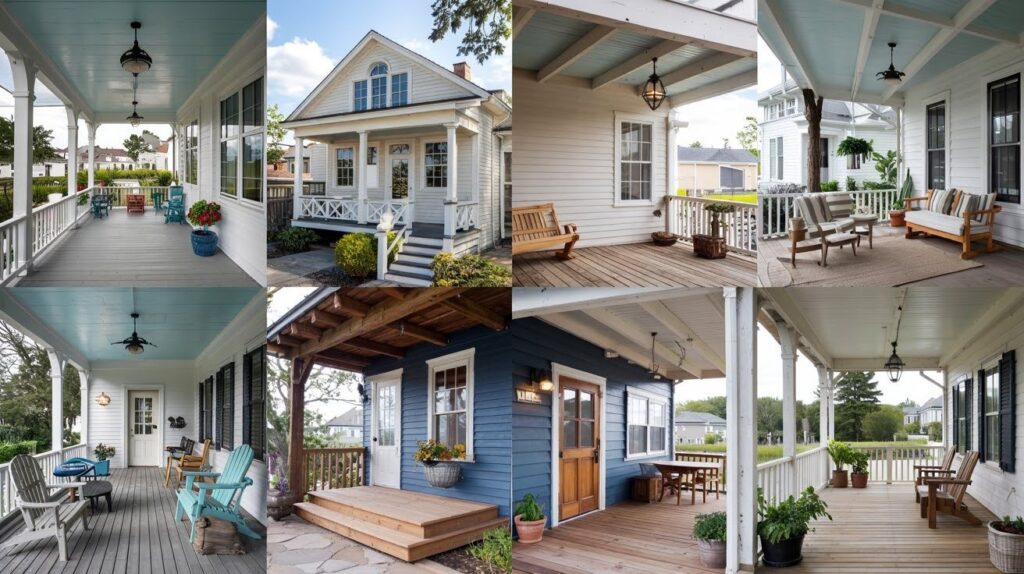
While blue porch ceilings originated in the American South, this design trend has expanded far beyond its regional roots to become popular across the United States.
Where It’s Commonly Found
The strongest concentration remains in Southern U.S. cities like Charleston, Savannah, and New Orleans, where the tradition stays embedded in local architecture.
The practice has spread to coastal New England areas and modern farmhouse homes nationwide as homeowners seek authentic traditional details.
Resort and vacation destinations including beach towns, lake communities, and mountain retreats now feature blue porch ceilings as part of their relaxed atmosphere.
The trend appears from California to New York as the farmhouse design movement carries this historical element across regions.
Why It’s Gaining Popularity Nationwide
Blue porch ceilings create striking contrast with popular white and gray exteriors, providing visual interest without overwhelming the design scheme.
The versatility allows them to work well with coastal and traditional home styles beyond Southern origins, including Cape Cod, colonial, craftsman, and contemporary designs.
Social media influence has spread this trend nationwide through home design platforms and lifestyle blogs that showcase these colorful ceilings.
The relatively simple painting process makes this an accessible upgrade for homeowners seeking maximum visual impact with minimal investment, contributing to its growing popularity outside traditional Southern markets.
How to Choose the Best Shade for Your Blue Porch Ceiling
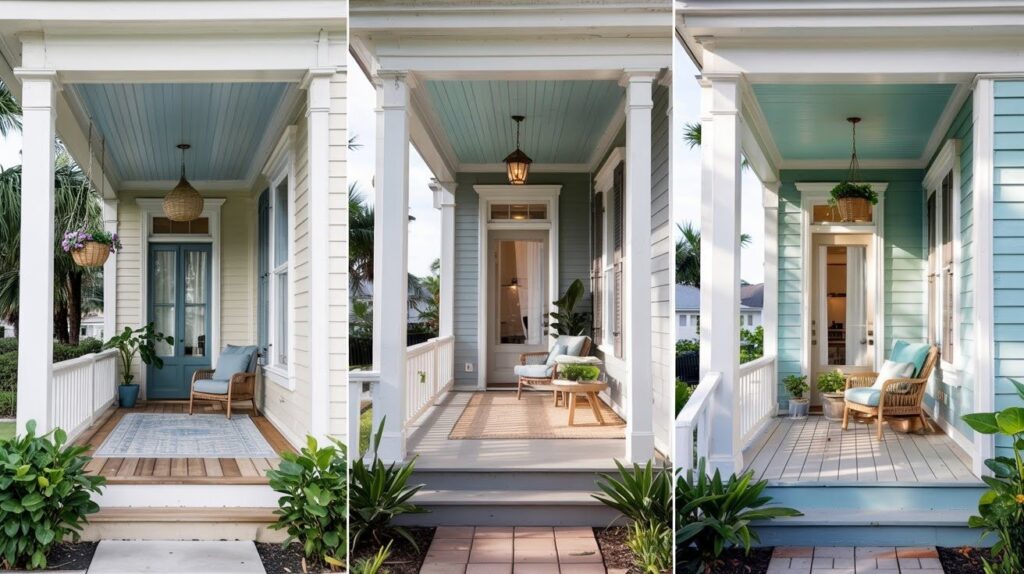
Selecting the right blue shade requires considering your home’s existing colors, lighting conditions, and personal style preferences to create the perfect complement to your exterior.
Popular Haint Blue Paint Colors
Sherwin-Williams offers Porch Ceiling, a classic light blue-green true to traditional haint blue origins, plus Tradewind for deeper aqua tones, Upward for softer powder blue, and Atmospheric for contemporary gray-blue that works with modern exteriors.
Benjamin Moore features Woodlawn Blue with authentic green undertones, Palladian Blue for crisp clean looks with white trim, Wedgewood Gray for sophisticated blue-gray options, and Antiguan Sky for tropical-inspired lighter shades.
Valspar, Glidden, and BEHR provide accessible alternatives including Sea Breath for gentle aqua tones, Everglade Mist for subtle green-blue in natural settings, and Wynwood Spring for fresh blue-green combinations.
Factors to Consider
- Amount of natural light on the porch – Sunny porches handle deeper blues, while shaded areas need lighter shades to avoid feeling gloomy.
- Color of siding and trim – White or cream trim pairs with most blues, gray exteriors work with blue-grays or cooler tones, and warmer beige or tan siding complements blue-greens and aqua shades.
- Ceiling material and texture – Smooth surfaces show accurate color, while textured ceilings may appear darker due to shadows.
- Sheen: flat vs. glossy – Flat finishes provide authentic historical looks but need frequent touch-ups, while semi-gloss or satin offers better durability and easier cleaning for high-traffic areas.
Tips for Painting Your Blue Porch Ceiling
- Test swatches directly on the ceiling – Paint large sample patches on your actual ceiling surface rather than relying on small color cards, as natural lighting and ceiling material affect color appearance throughout the day.
- Use primer to get accurate color – Apply high-quality exterior primer before painting to ensure the blue appears true to the paint chip and provides better adhesion on previously painted surfaces.
- Don’t use cross-brand color matches – Stick with the original manufacturer’s formulation rather than having another brand match the color, as matching systems can produce variations in undertones.
- Choose sheen based on ceiling condition – Select flat paint for rough or imperfect ceilings to minimize flaws, while semi-gloss or satin works better for smooth ceilings needing regular cleaning and durability.
Conclusion
A blue porch ceiling offers compelling visual, cultural, and aesthetic benefits that make it worth considering for your home.
This time-honored tradition creates an open, airy atmosphere while adding serene charm to outdoor spaces.
The rich cultural history connects your home to meaningful Southern heritage and spiritual protection beliefs.
When choosing the right blue for your property, consider your home’s natural light exposure, existing siding colors, and ceiling material.
Test paint samples directly on the surface and use quality primer for accurate results.
With options ranging from traditional haint blues to contemporary gray-blues, you can find a shade that complements your architectural style while creating a welcoming outdoor retreat that guests will remember.
Frequently Asked Questions
What is the best blue paint color for a porch ceiling?
The most popular options include Sherwin-Williams Porch Ceiling for traditional haint blue and Benjamin Moore Palladian Blue for a crisp, clean look. Your choice should depend on your home’s exterior colors, lighting conditions, and personal style preferences.
Do blue porch ceilings work with all home styles?
Yes, blue porch ceilings complement various architectural styles including coastal, farmhouse, colonial, craftsman, and contemporary designs. The key is selecting the right shade intensity and undertones that match your home’s overall aesthetic.
How does lighting affect the appearance of a blue porch ceiling?
Natural light significantly impacts how blue paint appears throughout the day, with sunny porches handling deeper blues better than shaded areas. Test paint samples directly on your ceiling surface to see how the color looks in your specific lighting conditions.
What paint finish should I use for a porch ceiling?
Flat finishes provide the most authentic historical look and hide surface imperfections well, but require more maintenance. Semi-gloss or satin finishes offer better durability and easier cleaning, making them ideal for high-traffic porches.
Can I paint a blue porch ceiling myself?
Yes, painting a porch ceiling is a manageable DIY project with proper preparation and the right tools. Use high-quality exterior primer before applying paint, and consider the ceiling height and your comfort level working overhead.

